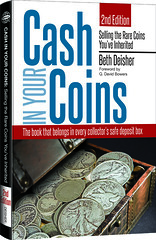
PREV ARTICLE
NEXT ARTICLE
FULL ISSUE
PREV FULL ISSUE
BOOK REVIEW: CASH IN YOUR COINS, 2ND EDITIONMike Marotta submitted this review of the new edition of Beth Deisher's book. Thanks! -Editor
The punning title could be an indication of the double purpose that this book can serve. It is intended for the person who knows nothing about numismatics. Although I do know something, I found Cash in Your Coins enlightening. I am ignorant in many areas of U.S. numismatics. When I worked for Coin World as their international editor, Bill Gibbs assigned me several tutorials in American numismatics. I had to produce publishable work on topics such as the pattern coins of 1792, the Paquet double eagles, and national currency paper money. So, for me, this book is useful, independent of its intended audience, those who have inherited a coin collection. I believe that the core of the presentation includes information that should be in the Red Book. The Red Book credits the Large Cents 1796-1807 to Robert Scott. Deisher nods to Gilbert Stuart and John Eckstein for the obverse and Joseph Wright for the reverse. In that, Deisher agrees with Breen and Taxay; argue it as you wish. I can recommend this book highly to anyone collecting the broad spectrum of American coins. Perhaps the strongest feature of Cash in Your Coins is its suggestion that the new owner of someone else’s trove start with Lincoln Cents. Any collection is likely to have pounds of them in jars or cans. Sorting them and searching through them will provide a basic introduction to numismatics as a collecting hobby. It also will foreshadow the real work of evaluating a large collection. Of course, numismatics is more than "coin collecting"; and American federal coins are just one interest area. However, statistically, most Americans collect American coins. So, of necessity, the chapter on paper money is cursory, beginning with the Federal notes of the Civil War. Tokens, medals, and foreign coins are all in one chapter. Ancients are not addressed at all, except to contrast the ubiquitous Widow’s Mite with the 1995-W Silver Eagle in Chapter 10, "Determining Value." Of all the quibbling that could resonate with E-Sylum readers, I found the use, over-use, misuse, and abuse of quotation marks annoying. However, when I worked at Coin World, Beth Deisher was two tiers above me, so I have to consider that modern English is what the editors say it is. Once, writing documentation for some software engineers, I pointed out to one that he was not even following the high school grammar books. He replied that languages change before the new style is accepted by academics. "So," he said, "if you are following the manual, then you are not using the current version." A more substantial problem for me was the lack of important information about pricing at the opening of the narrative. Deisher cites the Red Book several times, never warning the reader until pages 210-211 that dealers do not pay Red Book prices. Finally, in Chapter 10 she does nicely dissect the distinctions among the Red Book, Blue Book, Greysheet, and Bluesheet. You cannot say everything all at once on Page 1 but some forewarning could easily point to the later details. Although Deisher does identify important repunched dates for various issues, the term is never defined or explained. The discussion of die doubling, for example on page 48 for the famous 1955 Lincoln Cent, is cursory. It would not be a problem except that so many collectors are optimistic; and it is reasonable to expect that many collections are infected with misidentified "die chatter", if not for this one example, then for many other instances. Similarly, it is not until Chapter 8, on page 169, amid the private tokens and medals, that Deisher alerts the ignorant inheritor of the likely presence of fakes. Any large accumulation can have several or many, too often unidentified. That brings me back to why it is so easy to endorse this book for its substantive content. I failed the test on page 169. Clearly, I do not know what a Morgan Dollar looks like. I have one on my desk, but the test was not to compare mine to two pictures; but to choose between the illustrations. I failed. So, for me, this book is an important addition to my library and will sit next to the Red Book. To read the earlier E-Sylum article, see:
THE BOOK BAZARREWayne Homren, Editor The Numismatic Bibliomania Society is a non-profit organization promoting numismatic literature. See our web site at coinbooks.org. To submit items for publication in The E-Sylum, write to the Editor at this address: whomren@gmail.com To subscribe go to: https://my.binhost.com/lists/listinfo/esylum All Rights Reserved. NBS Home Page Contact the NBS webmaster 
|
